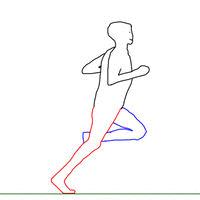Vertical Oscillation (Body Bounce) and Running
Vertical Oscillation is how much you "bounce" when you run. It seems rather obvious that greater Vertical Oscillation is going to be less efficient and reducing this movement will improve Running Economy. However, The Science of Running Economy does not really support this idea. There's evidence that if you intentionally try to increase your Vertical Oscillation by bounding higher on each step, that will make your Running Economy worse, but within normal running form the evidence is rather mixed. Like some other running metrics, there may be a "goldilocks zone" where there is an optimal range of Vertical Oscillation. This appears to be true of Cadence, though most runners have a cadence that's far too low, so excessively high Cadence is rarely seen.
Contents
1 Components of Vertical Oscillation
By definition, running involves a period of time when neither foot is in contact with the ground. This flight phase follows a ballistic curve, and is a component of the overall vertical oscillation. The only way to reduce the vertical oscillation during the flight phase is to reduce the time spent in the air, and the most effective way to do that is likely to be a higher Cadence. (This might be one of the reasons why a higher cadence is more efficient.) The other part of Vertical Oscillation is when one foot is in contact with the ground. The foot and leg decelerate the vertical movement of the body, then accelerate the body back up for the next flight phase. How rapidly the legs to decelerate the torso is referred to as Leg Spring Stiffness.
2 Vertical Oscillation and Cadence
Vertical Oscillation is directly related to Cadence, and most research doesn't look at these two factors separately. Ideally, research would look at how Running Economy there is with Vertical Oscillation at a fixed Cadence. It's possible that research indicating differences in Running Economy due to Vertical Oscillation are actually down to underlying changes in Cadence. Of course, it's also possible that the changes in Running Economy due to improved Cadence are actually because a higher Cadence reduces Vertical Oscillation.
3 Vertical Oscillation and Arm Swing
One fascinating aspect of Vertical Oscillation is the way it interacts with arm swing. Because our arms swing in time with him vertical movement, the effective length of the pendulum formed by the arm is actually much shorter than you would expect. The image below is from High Speed Video Analysis. The sold blue line traces the movement of my elbow as I run. The software has estimated the center that my elbow is rotating around, shown as the dotted blue circle. This means the natural frequency of my arm while running is much closer to the ideal Cadence of 90 strides/minute than you'd otherwise expect. If you're interested in the physics, continue reading after the diagram, otherwise skip to the next section.
While my elbow is physically rotating about my shoulder, the vertical movement means the effective center of rotation is different. This rotation point is half way down my upper arm and the effective length of the pendulum is much shorter. This is important because the length of the pendulum defines its natural frequency. My upper arm is about 12"/30cm long, which would be a period of 1.1 seconds or a Cadence of only 55 strides/minute. Taking into account that the effective length of my arm when running is about half that, the period is 0.78 seconds or 77 strides/minute. Of course, my arm is not a simple pendulum, and the angle of my forearm will change the center of mass of the pendulum. Holding my hands higher will move the center of mass closer to the pivot point, and increase the frequency. I suspect this is why runners with a low cadence hold their arms much lower. It's hard to know whether the Cadence or the low hand position is the cause of the problem, but they are intertwined.
4 Measuring Vertical Oscillation
Mostly, Vertical Oscillation is measured as the vertical movement of the torso. It is sometimes argued that actually we should measure the vertical movement of the center of gravity (COG) of the body rather than just the torso, but this is difficult as each body segment needs to be measured and analyzed. A study used motion capture technology to track 13 body segments with 36 reflective markers of runners at various paces. They found that the difference between COG and torso measurement was between 0mm and 1.5mm with lower discrepancy at faster paces[1].
For walking, some research has found there's no difference between the torso and COG[2]. One study did find a difference in measured Vertical Oscillation of the torso and COG in walking, but only at fast paces of 13-16 min/mile[3].
5 References
- ↑ Lennart Gullstrand, Kjartan Halvorsen, Fredrik Tinmark, Martin Eriksson, Johnny Nilsson, Measurements of vertical displacement in running, a methodological comparison, Gait & Posture, volume 30, issue 1, 2009, pages 71–75, ISSN 09666362, doi 10.1016/j.gaitpost.2009.03.001
- ↑ Steven A Gard, Steve C Miff, Arthur D Kuo, Comparison of kinematic and kinetic methods for computing the vertical motion of the body center of mass during walking, Human Movement Science, volume 22, issue 6, 2004, pages 597–610, ISSN 01679457, doi 10.1016/j.humov.2003.11.002
- ↑ Mandyam A. Thirunarayan, D. Casey Kerrigan, Marco Rabuffetti, Ugo Della Croce, Meera Saini, Comparison of three methods for estimating vertical displacement of center of mass during level walking in patients, Gait & Posture, volume 4, issue 4, 1996, pages 306–314, ISSN 09666362, doi 10.1016/0966-6362(95)01058-0




